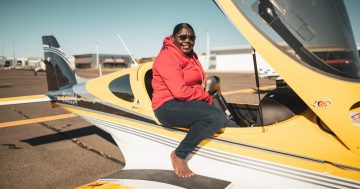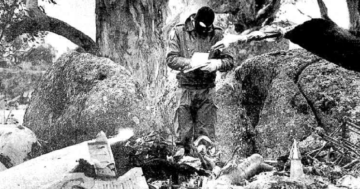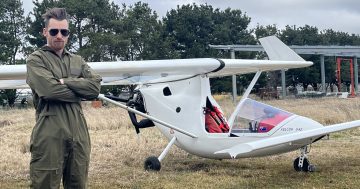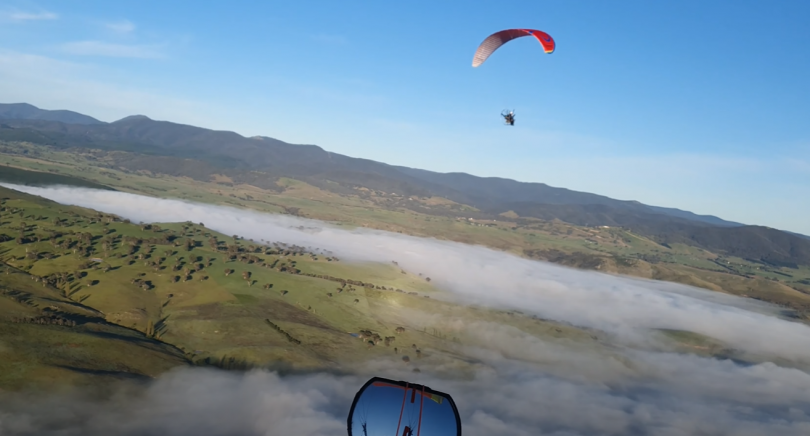
Dr Peter Evans flying high over the fog in the Murrumbidgee Valley with another pilot. Photo: Peter Evans.
Hot-air balloons are filling the morning sky with colour for the annual Canberra Balloon Spectacular, but they’re not the only thing in the wild blue yonder.
For the past seven years, there has been another; a man, armed only with a fabric wing, propeller and, perhaps strangely, a fear of heights.
Dr Peter Evans first attempted hang gliding in the 70s while studying at the Australian National University.
“Thankfully, I didn’t learn to fly then because hang gliders were still fairly primitive at that stage,” he says.
He received a proper introduction in 1987 and has been flying hang gliders since. After decades of teaching at educational institutions, Peter retired in 2015 and summoned the courage (and gear) to add a two-stroke ‘paramotor’ to the experience.
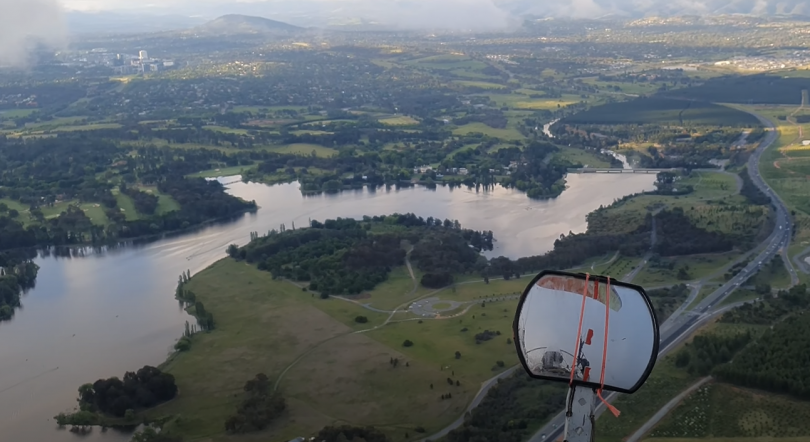
Overlooking Scrivener Dam. Photo: Peter Evans.
Nowadays, he regularly dons a backpack equipped with its fuel tank, engine and propeller and takes off to spend hours in the sky.
“I can take it out of the back of my car, set it up in 15 minutes, take off and then do quite significant flights, with the longest single flight so far being 313 km,” he says.
“I’ve had some absolutely fantastic experiences, flying around Canberra in my powered paraglider.”
In 2018, he and several other pilots flew from Lake Eyre in South Australia to Mount Kosciuszko in NSW – from the lowest point in Australia to the highest point. The following year, he flew about 3000 km from Bendigo in Victoria to the Gulf of Carpentaria over 20 days – and the ambition is far from abating.
“In July this year, a group of pilots are planning to fly from the western-most point of mainland Australia to the eastern-most point. So that’s from Steep Point in WA to Byron Bay in NSW. That’ll be about 5000 km.”
He captures videos from the lofty heights and posts them to his YouTube channel, giving others the chance to see the land as never before.
“I guess I’m not of the Instagram generation, so these videos are my future guarantee against dementia,” he says. “I can look back on those videos when I can no longer fly. I’m really doing them for myself.”
Peter says it’s not something interested punters can simply get up and decide to do one morning.
“It’s the sort of thing that you need to train for. There are set courses, set schools and set qualifications. You need to demonstrate physical skills in controlling the aircraft and pass exams in aeronautics, air law, and meteorology,” he says.
Flying around on your own device may have been less regulated when Peter started, but nowadays, hang gliders and paragliders fall under the same rules as other light aircraft and require a licence with the Sports Aviation Federation of Australia (SAFA).
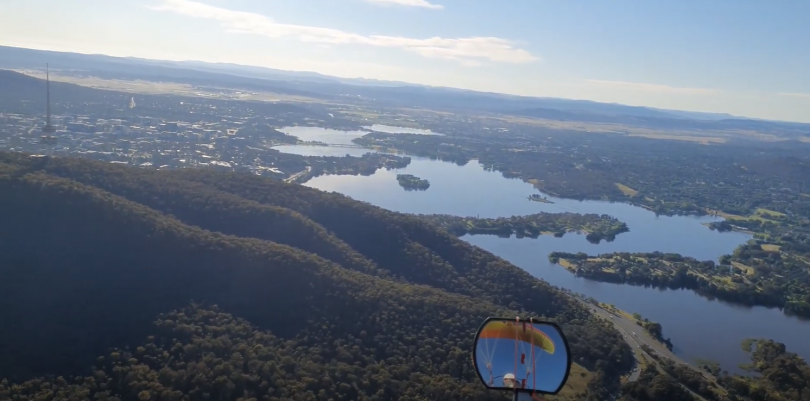
Black Mountain Tower overlooking Lake Burley Griffin from the air. Photo: Peter Evans.
Then there is the gear itself. The wing costs upwards of $4000, the backpack paramotor $9000 and the emergency parachute about $1500 – and that’s before other paraphernalia like protective boots, a helmet and, for cross-country flights, an aviation radio and other navigational instruments.
For those who just want the experience with a fraction of the cost and hassle, Peter recommends tandem flights which cost between $200 and $300.
“It will give you a good sense of whether or not it’s something you want to pursue further,” he says.
The paramotor allows the pilot to take off from smaller areas but they still need to run to build up airspeed. Recently, he added wheels, saying, “I always planned to get a wheelbase before a wheelchair”.
Once airborne, it isn’t just a case of sitting back and drifting along.
“It’s not like you are just up there, floating around without a care in the world. There are things I have to do, equipment I have to monitor, airspace to avoid, radio calls to make and navigation to plan. But it’s still absolutely fantastic,” he says.
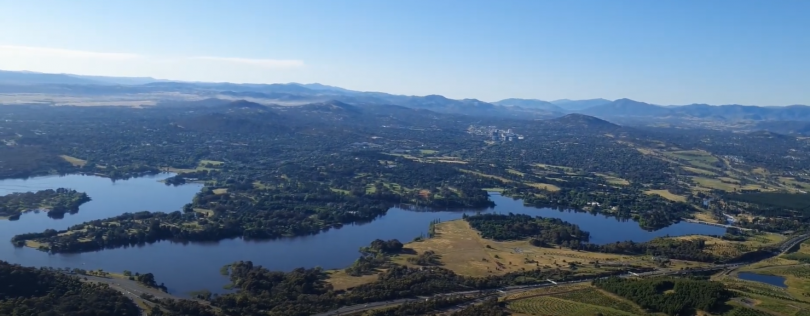
Lake Burley Griffin. Photo: Peter Evans.
Peter says the best tailwinds are found at altitudes around 2000 m, which is why it might come as a surprise to discover he suffers from a fear of heights. He says being strapped to a wing makes all the difference.
“If I’m strapped to a paramotor and I’m confident in the wing and the conditions, that’s a different situation to being at the edge of a cliff or looking out of a skyscraper’s window. Being scared of heights when you’re not tied onto something is a very sensible thing,” he says.
For Peter, gliding is a chance to reflect on perspective.
“When I’m flying under my fabric wing, I’m a very small spec in a large sky that is totally indifferent to my plans. I’m in its world.”












